Fences, Walls and Wires at State Borders
In early spring of 2019, after starting from Bihać, walking through the snow for days and swimming across the almost frozen Kupa river, three young Moroccans found themselves in front of a “four to five meter high steel fence with barbed wire on the top”. The first to climb the barrier cut his hand on the wire, while the other two managed to cross it without injury. However, armed police officers were waiting for them on the other side.
The fence, part of which, according to one of the reports on pushbacks, is described here in brief, is only one of the numerous and multiplying obstacles on the external borders of local and other territories. The fence in question is located at the state border between Slovenia and Croatia, largely placed in nature so that, as an element of the fencing/walling/wiring system for anti-migrant purposes, it would form part of the weaponized landscape. Injuries resulting from the wire, which is called barbed wire in this case, although it is more likely to be the even more dangerous razor wire, are also only some of the injuries that people on the move are exposed to when attempting to cross borders (cf. game).
Apart from the aforementioned Slovenian-Croatian barrier, others were also erected at these borders. The Hungarian barrier towards Serbia was erected (Korte 2022) before the Slovenian one, and the barrier towards Croatia was added later. At that time, Austria started to build a barrier towards Slovenia. Bulgaria started building a barrier towards Turkey in 2014, as did Greece two years prior. After the Hungarian barrier, Macedonia started building one towards Greece, a new Hungarian one towards Serbia was also erected, parallel to the first one, and Serbia began construction on one towards Macedonia. These barriers erected in connection with the Balkan route were preceded or followed by other contemporary European barriers, such as the Spanish barrier towards Morocco, the Lithuanian and Latvian barrier with Belarus, the British-French barrier in Calais, the Polish barrier towards Belarus, etc. Whether they were EU, intra-EU, i.e. Schengen, intra-Schengen or “only” European barriers, all of them are simply parts of “world” fences, walls and wires quickly erected in recent years and decades, and primarily – although other, anti-terrorist and anti-smuggling, reasons were cited as well – as protection from migrants (cf. e.g. Vallet 2019). Thus, the primary reason for the barriers related to the Balkan route is openly stated as defense against migrants. After all, although they were brought up as ideas before (Beznec et al. 2016: 40-41), the construction of external fences, walls and wires in this region began in the summer of 2015, which was interpreted, cynically, as a “construction response” to the “wave of illegal migrants” or as a “way to cope with the ongoing refugee crisis” (Sicurella 2017).
These barriers, referred to in the media as barbed fences and barbed wires, border fences, walls made from barbed wire, wire fences and razor wires, differ significantly from each other in terms of technical characteristics, i.e. the material used, complexity and overall physical form. They are composed of a whole spectrum of obstacles, from technologically very simple ones to sophisticated ones, from wire in coils simply thrown on the ground or stuck on metal poles, to panel fences with or without wires at the top and at the base, and the so-called smart, SF or high-tech Hungarian fence, as it is, due to its method of construction, materials and components such as heat sensors, electric shocks, cameras and speakers (cf. Kallius 2017), called by the media.
One of the common characteristics of these various types of barriers is their constant openness to changes, additions, reinforcements and extensions. For example, the Slovenian barrier towards Croatia that was first widely announced to be demolished in the spring of 2022, in connection with political changes in Slovenia, with the demolition starting and stopping during the summer of the same year, has been upgraded several times over the years until finally – although this is not known precisely to the public, supposedly for the sake of protection from smugglers – it reached a length of about 200 kilometers, around one third of the entire length of the border between Slovenia and Croatia. In addition to being extended, the barriers are also doubled up, such as the Hungarian one against Serbia in 2017. In the summer of 2022, the media reported that Hungary would once again upgrade its existing barrier towards Serbia, making it higher. This case is also an example of frequent associations of border barriers with different types of announcements, about their installation or removal, warnings, threats, offers and related discourses.
Barriers related to the Balkan route are placed in different locations, taking into account, among other things, the position of the border in relation to populated areas. While some are erected only where no so-called natural borders exist, such as the Hungarian barrier towards Croatia, others are placed right next to them, for example, along the already mentioned Kupa river on the Slovenian-Croatian border. In addition, different types of barriers are erected on different terrain: locations that are allegedly less used for illegal crossings on the Hungarian border were planned to feature a simpler type of barrier, and where crossing attempts are more frequent, another, more efficient type of barrier was planned.
In some places, border barriers are placed far from settlements and erected in inaccessible or at least less visited parts of the landscape, and in others they are located very close to settlements or visited locales. For instance, in some parts of Hungary, along its borders with Croatia and Serbia, barriers are placed “in the middle of the field”, in a landscape with no natural obstacles, so they can only be seen by zooming in on photos taken from a distance, which makes the border visible. In order to reach these obstacles, one has to make a certain effort, because the fields are located far from the road, as well as from the places where people live, work or stay. Thus, even those living in their relative vicinity do not necessarily know exactly where the barriers are placed and how to reach them, as a local woman in Kneževi Vinogradi told us during one of ERIM’s research interviews in May 2022.
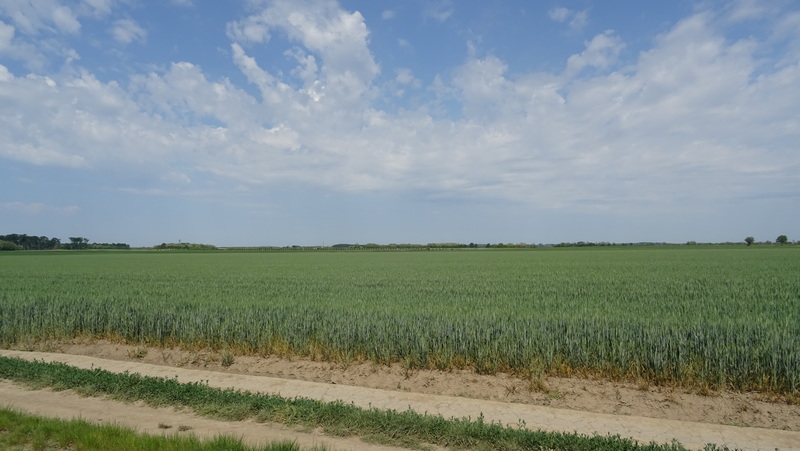
The Hungarian barrier “in the middle of the field”. Bački Breg, 16 May 2022. Photo: Marijana Hameršak
Some barriers are placed in the immediate vicinity of locations where people gather, but are not clearly visible at first glance. The river bank near Brod na Kupi, a popular bathing location during the summer, is separated at the Slovenian side by a wire, which, however, has almost been overgrown by the vegetation on the river bank on the Slovenian side, and thus is only noticed later, sometimes not at all. The example of the wire found in the river is a testament to the violent and grotesque integration of certain barriers into nature.
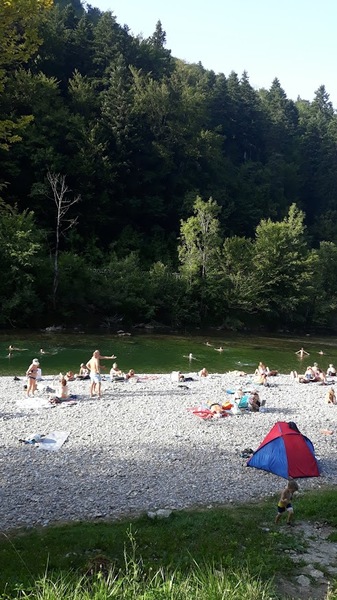 |
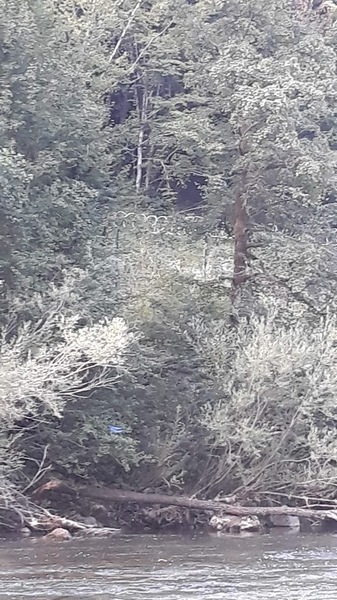 |
| Bathing site near Brod na Kupi. Left: Beach and forest by the river. Right: Forest by the river in close-up, with the wire visible. 12 August 2019. Photo: Iva Pleše |
Local knowledge about fences, walls and wires depends not only on their proximity or distance from a place where people live or gather, but also on the existential or some other interest of the people who live in those areas. For example, the residents of Preševo near the Serbian-Macedonian border, who researchers spoke to in June 2020, mostly did not even know that Serbia was erecting a barrier towards North Macedonia. On the other hand, in Miratovac, a village located ten kilometers from Preševo towards the border, the situation was completely different, as land was taken from the residents there, allegedly without compensation, in order to erect the barrier. In addition, the barrier affected their daily lives by making it difficult for them to reach the land that was now on the other side of the “fenced” border (KlikAktiv 2021). While referring to the barriers erected near them in various media articles, people in different locations talk about the negative impact on the local economy, primarily tourism, or on leisure activities. However, some are also, even if they do not point to the benefits of barriers and the controls associated with them, at least less critical of fencing, such as the owner of a camp next to Kupa in the border area of Slovenia and Croatia, who compared the erection of a barrier on the external border of Slovenia to building a fence around a house or with fences in cities that surround factories for protection. Accepting the barrier as an inevitability and its integration into normal activities is clearly visible in certain Slovenian border areas towards Croatia, where there are “plenty of open doors in the wire”, and where “people walk their dogs”, while policemen lubricate the latches on the doors or “take care of the fence”, as one of the ERIM researchers wrote in her field notes in late spring 2022. Researchers gathered around the Fencing Borders project, which visually, aurally and in other ways documents the barriers erected along the borders in these areas, try to convey the grotesque atmosphere which arises when the wire is combined with everyday life in a short video entitled “Birthday by the fence”.
In addition to places far from the official border crossings, fences, wires and walls are also erected at the border crossings themselves or near them, and smaller, protective fences against an inrush, as they are called in the documents, are also used in these places, i.e. movable fences/doors. Barriers at the borders are also similar to Jersey walls (concrete blocks) and related obstacles which block only certain points on the borders, more precisely roads and gravel roads, or bridges, and, in a broader sense, barriers at the border also include cleared areas such as the one created by cutting down the forest on Plješivica. In various locations, bridges that were built to connect (cf. Riman and Škiljan 2018: 433-434) now feature barriers that give a strong sense of separation and stop movement.
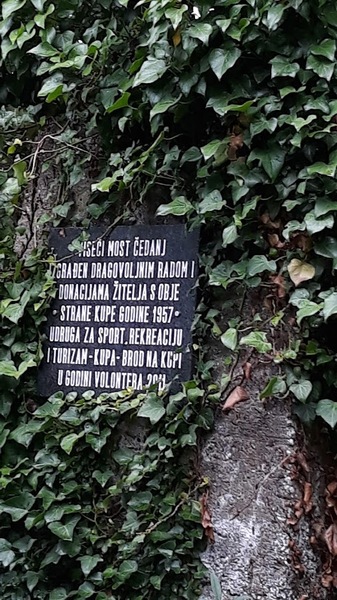 |
 |
| Suspension bridge in Čedanj, Gorski Kotar. Left: Inscription on the plaque commemorating the construction of the bridge in 1957. Right: Wire on the bridge. Čedanj, 14 August 2019 Photo: Iva Pleše |
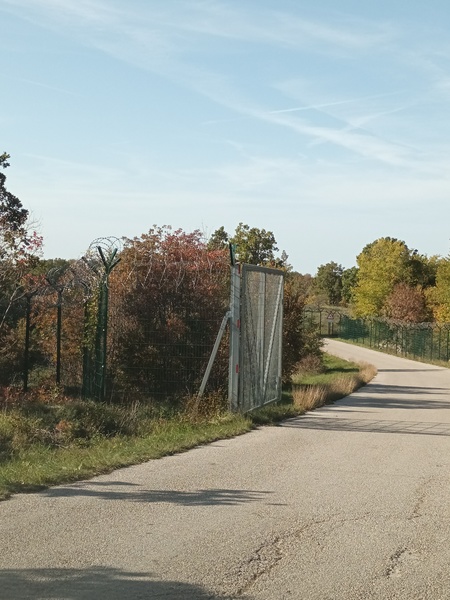 |
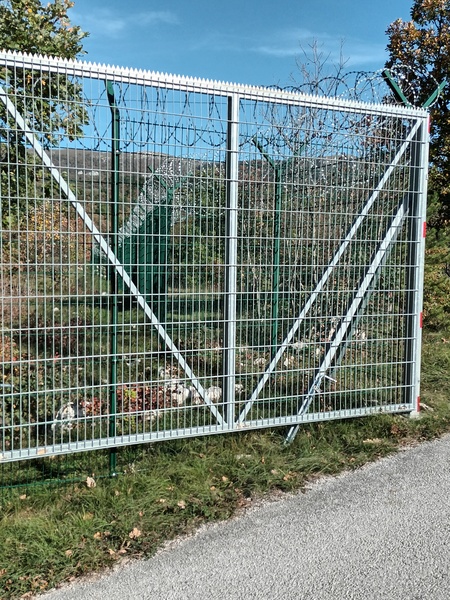 |
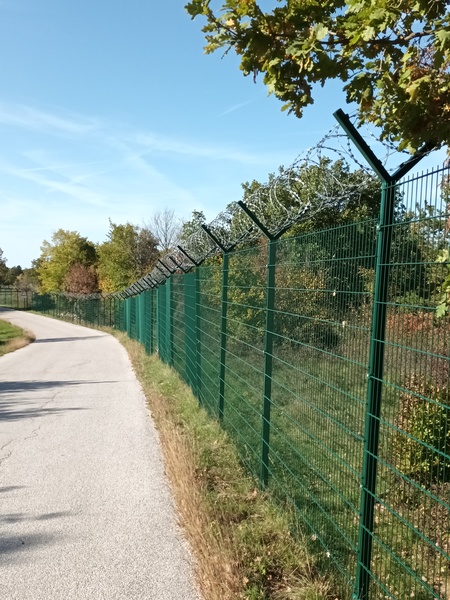 |
| Slum/Rakitovec border crossing at the Croatian-Slovenian border. Left and center: Open movable fence/gate near the border crossing. Right: Fence with wire on top, placed along both sides of the road leading to the border crossing. Slum, 31 October 2022. Photo: Iva Pleše. |
In addition to the fact that, as mentioned earlier, the barriers are upgraded and their numbers increase, they can also be moved after they have been installed or are still being planned, for example closer to a river or further away from a river. They are also removed, for instance, the wire placed near the village of Žuniči along the Slovenian-Croatian border on the Kupa river was removed before the summer of 2018, due to, according to hearsay, the death of people on the move at that location, as the river is relatively shallow there, leading to people trying to cross at that point. However, they would often get cut on the barrier, so they had to be taken care of. So, on the one hand, the wire did not stop crossings across the river and the border, and on the other hand, it created additional problems for Slovenian services, so they removed it.
As could be seen from the description of crossing the barrier on the Kupa river given earlier, the physical barriers at the borders have been strengthened, for example, with surveillance cameras and drones, officially or unofficially, with manpower, but also with animals. For example, one media report mentions a small group of well-armed and publicly financed Hungarian rangers who patrol “the forests in search of migrants coming across the border with Serbia”. The documentary film Žica (Wire) by Tiha Dugac shows a Slovenian family who guard the border on their own initiative and whose adult members sneak under the wire to check if someone is camped on the other side, near the wire, waiting to cross over to the Slovenian side. Unlike humans, who can act independently, animals become border guards with the help of humans. In May 2022, members of the No Name Kitchen collective published posts on social networks describing the injuries of migrants caused not by the wire itself, but coming from dogs near the barrier, which were unleashed by two border police officers on the Hungarian side when they saw them. This description speaks to barriers that are “supported” by both humans and animals. At the same time, animals as victims is one of the recurring themes of local discourses related to fences and wires.
In addition to the already mentioned role of border barriers in physically harming those who try to cross them, we should also emphasize the susceptibility of these barriers to different migrant circumvention strategies (cf. Vallet 2019) which include, organized independently or by smugglers (cf. Beznec et al. 2016: 50-51), cutting the wire, jumping over obstacles as described at the beginning of the text, digging tunnels, crawling under wires, using ladders, digging holes (klikAktiv 2021) or finding terrain with no barriers because, for example, they are harder to erect at certain locations. This also reveals the danger of the terrain that people on the move have to traverse if they choose this route, as noted in one of ERIM’s research interviews in the spring of 2022 in Gorski Kotar, related to crossings over the Kupa: “They go where there is no wire, and those places are dangerous, steep, fast”.
Finally, fences, walls and wires play a role in initiating actions, protests and discourses contrary to those characterized by fortifications, borders, supposed defense and violence. In this sense, this ending will include an act of such resistance, in which a rendition of the globally famous song Clandestino is dedicated to illegals, performed by LeZbor, differing from the original lyrics, but following their meaning with a text that highlights the fence, wall or wire as an essential feature of the European attitude towards people on the move and talks about razor wire on all sides, across the sea and the Balkans... they chase us like dogs, but we must press on / your fortress Europe is countless steps away / we dream only of one thing, to live as people / Moroccan illegal / Pakistani illegal / Syrian illegal / solidarity – crime!
16/1/2023
Literature
Beznec, Barbara, Marc Speer and Marta Stojić Mitrović. 2016. Governing the Balkan Route. Macedonia, Serbia and the European Border Regime. Beograd: Rosa Luxemburg Stiftung Southeast Europe.
Kallius, Annastiina. 2017. „“The Speaking Fence“. Anthropology Now 9/3: 16-23.
klikAktiv. 2021. „Border Fence at the Serbian-Macedonian Border“. Beograd: klikAktiv.
Riman, Barbara and Filip Škiljan. 2018. „Rijeka i planina, granica i ljudi. Studija slučaja života pograničnog stanovništva Donjekupske doline i Žumberačkog gorja“. Historijski zbornik 71/2: 401-439.
Sicurella, Federico Giulio. 2017. „The Language of Walls Along the Balkan Route“. Journal of Immigrant & Refugee Studies.
Vallet, Elisabeth. 2019. „Border Walls and the Illusion of Deterrence“. In Open Borders. In Defense of Free Movement. Reece Jones, eds. Athens: The University of Georgia Press, 156-168.